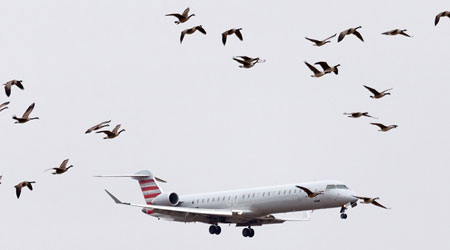
Facilities Near Runways May Promote Bird Strikes
December 2, 2019
Birds and planes are not a good mix. In September, a bird strike in Canada was captured on video. The 737's engines flared as it shredded up to four geese on ascent. A bird strike involving a flock of geese at LaGuardia caused the ditching of US Airways Flight 1549, famously known as the "Miracle on the Hudson." According to the Federal Aviation Administration (FAA), there were about about 194,000 wildlife strikes with non-military airplanes in the US between 1990 and 2017. And the buildings near runways may be partly to blame.
The FAA recommends a 5,000- to 10,000-foot buffer around runways that are free of wildlife attractants. However, a study at Midway Airport in Chicago found that Canada geese are hanging out on rooftops, a rail yard, and a canal close to Midway during the cold months of the year. As a result, between mid-November 2015 through February 2016 there were 399 times geese intersected the takeoff or arrival of planes, and 422 times when the geese were otherwise in the 10,000-foot buffer zone.
In a study published in Human-Wildlife Interactions, researchers from the University of Illinois collared 31 geese from within a 7.5 mile radius of the airport with GPS transmitters and tracked data on their position every hour for four months. Researchers found some un-gooselike behavior. The geese were hanging out on building rooftops and a canal, and visiting a nearby railyard, criss-crossing the runways in order to do so. The geese had discovered that during a cold Chicago winter, the roofs and canal provided warm shelter which allowed them to conserve energy. The rail yard provided a steady supply of moldy grain, which apparently beats frozen grass, from rail cars getting swept out after shipments. In short, goose paradise.
Researchers believe similar behavior could be observed at other airports in places with cold winters. That clever adaptive behavior is great for the geese, and not great for people in airplanes. Those with facilities near airports may want to ensure they are making their facilities less attractive hangouts for overwintering geese by removing potential sources of food and installing barriers or repellants on roofs.
Naomi Millán is senior editor of Building Operating Management.
Next
Read next on FacilitiesNet












